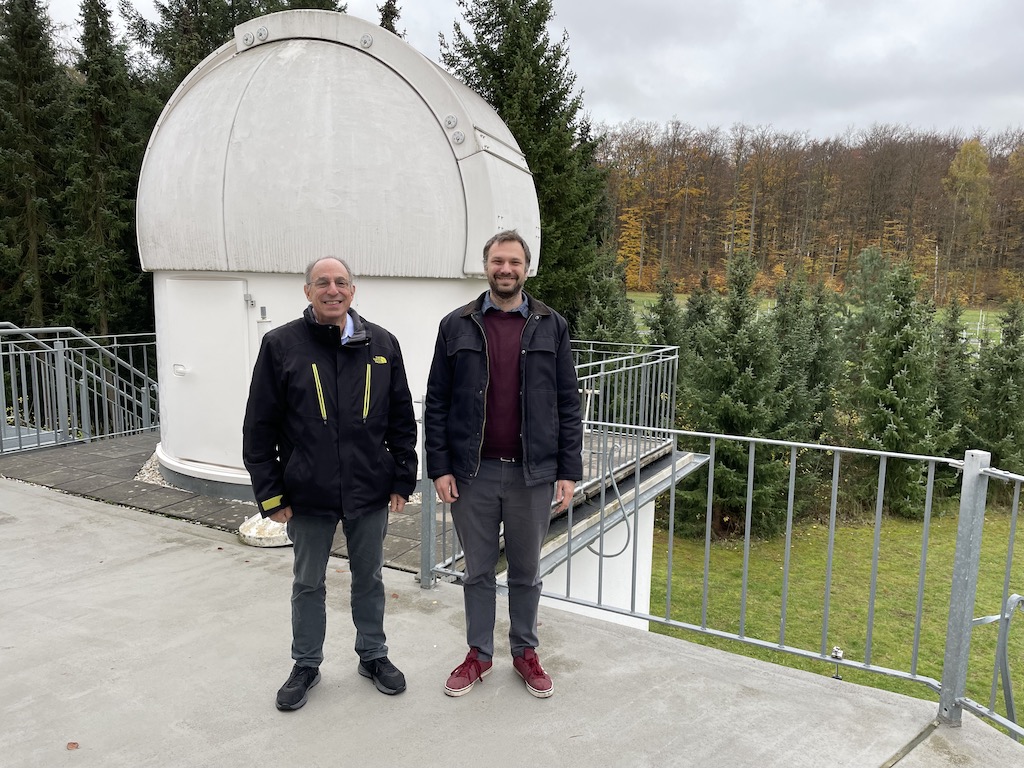There are a lot of advantages (and a few disadvantages) to applying Machine Learning to astronomy data sets. Rok Hribar, expert in Machine Learning, visited the Thuringian State Observatory in November 2024 to get a few projects going.
 Artie Hatzes (left) and Rok Hribar at the Thuringian State Observatory. Photo: TLSHribar is a researcher at the Computer Systems Department at the Jožef Stefan Institute in Ljubljana, Slovenia. He currently spends a year at DLR (Deutsches Zentrum für Luft- und Raumfahrt) in Berlin as part of the EXOWORLD staff exchange program supported by the European Union. The Jožef Stefan Institute is the leading Slovenian scientific research institute, covering a broad spectrum of basic and applied research. Like the Thuringian State Observatory, it is part of the EXOWORLD consortium. Artie Hatzes, researcher at TLS, invited Rok Hribar to spend a week in Tautenburg to talk to astronomers about joint Machine Learning projects. “It is great to have the opportunity to collaborate with an expert in Machine Learning because there are many applications in Astronomy that profit from it,” Hatzes says.
Artie Hatzes (left) and Rok Hribar at the Thuringian State Observatory. Photo: TLSHribar is a researcher at the Computer Systems Department at the Jožef Stefan Institute in Ljubljana, Slovenia. He currently spends a year at DLR (Deutsches Zentrum für Luft- und Raumfahrt) in Berlin as part of the EXOWORLD staff exchange program supported by the European Union. The Jožef Stefan Institute is the leading Slovenian scientific research institute, covering a broad spectrum of basic and applied research. Like the Thuringian State Observatory, it is part of the EXOWORLD consortium. Artie Hatzes, researcher at TLS, invited Rok Hribar to spend a week in Tautenburg to talk to astronomers about joint Machine Learning projects. “It is great to have the opportunity to collaborate with an expert in Machine Learning because there are many applications in Astronomy that profit from it,” Hatzes says.
Automating the process of data reduction
Astronomers produce a lot of observational data. Ideally, Machine Learning can automate the process of reducing and analyzing this data – doing it much faster than people can ever do it. “With Machine Learning, we can model things that people cannot process because the data set is too big. Machine Learning also reduces manual labor,” Hribar emphasizes the advantages.
In his colloquium talk, the computer expert described how Machine Learning is applied to astronomical data sets. Hribar already started a few projects with astronomers at DLR in Berlin, at Rheinisches Institut für Umwelt-Forschung an der Universität Köln in Cologne, and at Universita degli Studi di Torino, Italy. These institutes are also part of the consortium “Understanding the evolution of EXOplanets and towards habitable WORLDs (EXOWORLD)”.
How to set up a Machine Learning project
Hribar explains that a Machine Learning project is always an iterative process. First, the astronomers tell him, what problem they want to solve. Before starting, it is essential to discuss the problem in depth with the astronomer. Hribar outlines how he tackles a problem: “It is always useful to understand the astronomical question very well because that influences which method we will apply.”
“Usually people already have ideas where Machine Learning can be applied,” Hribar says. At the beginning, he looks at the data set which is used to train the Machine Learning model. What properties does the data have? Which properties are most important to solve the problem?
A Trial-and-Error-Process
The next step is choosing the methodology. That means preparing the data and choosing the appropriate Machine Learning model. “Preparation of the data is 90 percent of the work,” Hribar points out. When a chosen model works satisfactorily, the data and the model are fine-tuned. This is a trial-and-error-process.
One disadvantage can be that Machine Learning can hide things, Hribar says: “Traditionally, when you use a software to reduce data, you understand what the software is doing. With Machine Learning you don’t really know what the model is doing”. Therefore, one big question still is: How trustworthy are the results?
In order to deal with this question, a step by step process is applied: “We see the intermediate results and can better understand what the model is doing or where it might be wrong,” Hribar describes the correction mechanism. Validating each step brings confidence that the results are trustworthy.
During his visit to Tautenburg, Rok Hribar started some projects with scientists at the Thuringian State Observatory that will be developed further. Hatzes thanks him for sharing his expertise: “I really appreciate that Rok Hribar took his time to visit the Thuringian State Observatory. The scientists here were very interested in talking to him about possible projects.”
Background Information
The EXOWORLD project that funds Hribar’s research stay at DLR in Berlin is supported by the European Union under the Horizon Europe Programme Marie Skłodowska-Curie Actions Staff Exchanges (Project ID: 101086149). “Understanding the evolution of EXOplanets and towards habitable WORLDs (EXOWORLD)” is a consortium that comprises 12 organisations from eight countries. It leverages interdisciplinary and international expertise to study the diversity of exoplanets.

